Lifestyle
STA, 18 December 2020 - In the past seven days, the police dealt with almost 16,800 cases monitoring compliance with Covid rules. A total of 1,026 warnings were given, up by some 14% on the week before, and 519 fines were issued, down by 4%, deputy Police Commissioner Tomaž Pečjak said on Friday.
The police conducted 2,400 inspections per day on average to monitor compliance with coronavirus restrictions.
Mostly they dealt with violations of border restrictions, movement restrictions, including those restricting movement between municipalities, the 9pm-6am curfew or a ban on gatherings, Pečjak said at today's government briefing.
The police reported nine violations to the Health Inspectorate in the past seven days. Another 188 alleged violations were reported by municipality residents.
Health inspectors issued 35 sanctions between 7 and 13 December, 265 warnings and 100 administrative measures, having dealt with 2,303 cases, Deana Potza with the inspectorate told the briefing.
Violations include gatherings in the vicinity of food or beverage pick-up points or people wearing face masks wrong or not wearing them at all.
Most police warnings were issued by the Ljubljana Police Department (442), followed by the authorities in the Kranj area (81) and the Koper area (65), Pečjak pointed out.
When it comes to fines, the highest number was also issued in the Ljubljana area (154), followed by the Novo Mesto Police Department (149).
Pečjak said that the police were monitoring compliance with the curfew in cities and on major roads. However, most alleged violations are brought to the attention of the police by residents, he added.
The police issued 1,661 quarantine orders at border crossings between 11 and 17 December, an almost 19% increase on the week before. Most were issued on the border with Croatia (1,032), followed by those issued on the border with Austria (425), Italy (55) and Hungary (16).
At Ljubljana airport the police issued 133 quarantine orders in the past seven days.
The greatest number of quarantine orders was issued to passengers arriving from Bosnia-Herzegovina (437), which compares to 602 orders issued to arrivals from this country in the previous seven days.
A total of 287 quarantine orders was issued to arrivals from Germany, whereas a week before none, followed by arrivals from Croatia (209), Serbia (126), Kosovo (108) and North Macedonia (105).
The number of arrivals entering or exiting Slovenia on the border with Croatia increased by some 10% to 314,266 in the past seven days.
Compared with the same period last year, traffic on the border was reduced by two thirds, Pečjak said.
He urged those who intend to travel to learn about relevant conditions and heed prevention measures consistently, warning that a number of countries had made their entry requirements stricter.
The deputy police commissioner also announced that the police would step up their monitoring this weekend as well.
He added that if an individual wanted to invoke the contact tracing app #OstaniZdrav (#StayWell) as an exemption from the general ban on travel between municipalities, all they had to do was voluntarily show that the app had been installed on their phones.
In the event of an entire family travelling, it is sufficient if only one member claims this exemption, he said, highlighting that the app opened doors only to travel between the municipalities of the same region and only in the four regions with the best epidemiological status.
Tying unrestricted travel between municipalities to the use of the app has raised concern over privacy protection and discrimination of those who do not own a smart phone or a phone that could accommodate such an app, particularly the elderly and vulnerable groups.
STA, 18 December 2020 - Trial mass voluntary raid testing for the novel coronavirus will go ahead in Ljubljana on Monday, the Health Ministry has confirmed for the STA after Tomaž Gantar, who since resigned as minister, first announced the plan earlier this week. Testing will take place in Congress Square.
Testing will start at 10am on Monday, running until 5pm, and then from 8am to 5pm the following three days. Those who wish to get tested need to bring an identity document and a health insurance card.
The mobile lab will expectedly be able to perform 60 antigen tests per hour, meaning that around 2,000 tests could be performed in the first four days.
The testing will be organised with the help of Ljubljana city authorities. Members of the Ljubljana civil protection, possibly aided by city traffic wardens will provide the security, making sure social distancing rules are observed.
Those who wish to get tested are advised to bring protective face masks.
STA, 18 December 2020 - The epidemiological situation in Slovenia appears to be gradually improving. A total of 1,512 new cases were confirmed on Thursday, some 300 fewer than a week ago, in what was the sixth day running that week-on-week cases declined. A total of 41 Covid-19 patients died, according to the latest government data.
"From Saturday almost 900 fewer infections were confirmed than in the same period last week. This is an encouraging trend," government spokeswoman Maja Bratuša told the daily coronavirus press briefing.
Hospital figure declined as well. There were a total of 1,212 Covid-9 patients in hospital yesterday, down 17 on the day before and the lowest figure since mid-November. The number of patients requiring intensive care dropped by one to 207.
The new infections came from 5,862 tests, which means the positivity rate was 25.8%. Slovenia has so far recorded 103,555 coronavirus cases since the start of the epidemic, meaning almost 5% of the population has had a confirmed infection.
The number of people who died with Covid-19 stands at 2,233, according to data tracker Covid-19 Sledilnik.
All our stories on Slovenia and coronavirus
STA, 17 December 2020 - The government has formally extended the epidemic by another 30 days beginning with 18 December, government Covid-19 spokesman Jelko Kacin said on Wednesday evening. Museums, libraries and galleries have been given the go-ahead to reopen in regions with the best epidemiological status.
The set of restrictions that will be put in place during the holidays has not yet been agreed on, Kacin added. The government discussed the holiday regime that will be imposed to contain the spread of coronavirus, and is expected to reach a decision in the coming days.
In four regions with the most optimal epidemiological situation, central Osrednjeslovenska, Gorenjska in the north-west, coastal Obalno-Kraška and Goriška in the west, libraries, galleries and museums are allowed to reopen starting on Saturday.
Some museums may reopen on the first day, others are likely to wait until next week, the STA learnt after speaking to several museums.
Remote schooling is to remain in place at least until 25 December. After the holidays, a possibility that classroom learning will return has been floated.
Kacin remains optimistic and would like to see students back in school as soon as possible. The government does not wish to jeopardise this possibility by an excessive easing of the restrictions, he told the STA.
Regarding the holiday regime, he said that movement between municipalities could be perhaps permitted temporarily as well get-togethers of a restricted number of persons, however the government must be careful not to aggravate the situation.
The 9pm-6am curfew might be lifted as well and fireworks banned.
Bojana Beović, the head of the government Covid-19 task group, reiterated for commercial broadcaster POP TV on Wednesday that it would be sensible to impose a lockdown between 24 December and 4 January that would be as strict as possible to prepare for the January epidemic wave.
If it transpires that there is no surge in infections after the holidays, certain activities could be reopened, she said, highlighting the importance of social bubbles during the holidays.
The government also approved yesterday a EUR 4.5 million investment in a mobile facility for the Ljubljana UKC medical centre that is meant to boost the number of Covid beds during the epidemic.
STA, 16 December 2020 - Slightly less than 50% of Slovenia's residents intend to get vaccinated against Covid-19, which is a bit more than in November, the latest survey by pollster Valicon shows. Nineteen percent intend to get vaccinated for sure, up three percentage points, while 28% said they would probably get vaccinated.
As many as 57% said they would get vaccinated because it is responsible to others, with another 42% saying they would like to reduce the chance of getting infected.
Twenty-two percent have no intention whatsoever of getting vaccinated (down from 26%), with another 31% saying they would probably not get vaccinated.
Most of them cited distrust in the vaccine as the main reason, with as many as 60% saying the vaccine should be tested longer to prove safe. 43% also fear side effects.
Most of the respondents, 56%, blamed the poor epidemiological situation on people or their poor adherence to restrictive measures, and 38% on the government.
As many as 30% said all politicians should be blamed, with 22% pointing the finger at the Health Ministry's task force, which advises the government on coronavirus.
Just before the latest relaxation of measures kicked in on 15 December, the majority assessed restrictive measures were rather inappropriate.
The share rose from 29% two weeks ago to 41%, the highest so far, with only 14% saying the measures were appropriate.
The largest share so far - 57% - said the measures were too strict. 17% assessed them as adequate and over a quarter as not strict enough.
Valicon said that if the poll were carried out today, the public's response would be probably less negative as some of the measures had been additionally relaxed since the survey was carried out on 11-13 December.
The respondents were however less negative about the government's management of the epidemic's ramifications for the economy and households, although the figures are the worst so far.
The share of those who consider it inappropriate rose considerably, to 38%, while half of those polled said the approach was partly adequate and partly inadequate. 12% labelled it as very adequate.
The share of those who think the situation is worsening rose for the second consecutive time, to almost two thirds from 54% two weeks ago.
The public's trust in the government's handling of the epidemic has also dropped, to the lowest level so far, with 67% not trusting it and 27% trusting it.
The #NewNormal poll, surveying 534 respondents, measures the public's reaction to coronavirus-related measures and its perception of everyday life during the epidemic.
STA, 16 December 2020 - Slovenia confirmed 2,107 coronavirus cases on Tuesday as nearly a third of all tests came back positive, and another 39 Covid-19 fatalities. The total number of cases since the start of the pandemic has thus passed 100,000 and the death toll has risen to 2,190.
Data released by the government show that 6,579 Sars-CoV-2 tests were performed yesterday with a positivity rate of 32%, up 4.95 percentage points compared with the day before.
Still, the number of new cases confirmed yesterday was down by 32 when compared to the figure a week ago, as the daily rise in new infections was down on the same day the week before for the fourth straight day.
The number of patients hospitalised with Covid-19 dropped by 33 to 1,251 after 128 were discharged home and 117 were newly admitted. The number of intensive care unit (ICU) cases rose by seven to 211.
The seven-day average of new cases as of Monday is 1,477, and the 14-day incidence per 100,000 residents is 1,006, government data show.
According to the tracker site covid-19.sledilnik.org, there are currently 20,785 active cases in the country, out of a total of 100,389 confirmed so far.
Addressing the daily coronavirus press briefing on Wednesday, Tatjana Lejko Zupanc, the head of the UKC Ljubljana Department of Infectious Diseases, offered a glimmer of hope.
"In recent days we have the impression the situation is calming even if just microscopically. We're not very optimistic, but there's a ray of light because we have a bed free every morning."
However, she said they were "walking the edge" and the proportion of ICU cases was increasing, while the staff was tired, on the verge of burnout, even though committed and they were looking forward to the vaccine.
She said almost half of the Covid-19 patients admitted were older than 75 and that their average age was even higher than in the first wave, at 70, compared to 65 with the average at 69. About 13% of the hospitalised Covid-patients died, which is on a par with the first wave.
Nuška Čakš Jager, deputy head of the Centre for Infectious Diseases at the National Institute of Public Health, noted that the test positivity rate had not been changing much.
Surveys conducted by epidemiologists among those infected indicate that now the primary source of infections is family or household with an increasing proportion of those who cite socialising as the source of infection.
All our stories on Slovenian and Covid-19
STA, 14 December 2020 - Slovenia has been promised to get some 5,000 doses of anti-coronavirus vaccine by the end of the year, Health Minister Tomaž Gantar told MPs in questions time in parliament on Monday. This is the vaccine developed by Pfizer and BioNTech, which is expected to be green-lighted by the European Medicines Agency on 29 December.
However, Gantar is worried that given the strong anti-vaccination movement, Slovenia would in the long-run not achieve a 60% vaccination rate, which scientists deem necessary to guarantee herd immunity.
This is one of the reasons the country decided to buy the vaccine via the European Commission and the Medicines Agency, to raise trust in the safety of the vaccine, he told the MPs.
Once the entire first batch has arrived in the country, it is expected to suffice for 50,000-60,000 people. The country would earmark EUR 10.5 million for anti-Covid vaccination, which will be voluntary, this year.
In line with the national anti-coronavirus vaccination strategy, the first to be vaccinated will be healthcare staff and staff at care homes.
STA, 15 December 2020 - Slovenia's central bank will issue collector coins in the coming days to commemorate the 30th independence anniversary. This year's commemorative coins will mark the 500th anniversary of the birth of the author of the first Slovenian grammar book Adam Bohorič. The coins will be available for purchase starting on 23 December.
Banka Slovenije said it would bring into circulation 500 gold coins marking the independence anniversary at the price of EUR 420, 1,000 silver 50-euro coins, 40,000 bi-coloured regular three-euro coins, and 750 bi-coloured three-euro coins in BU quality at the price of EUR 16.
Slovenia in Your Pocket: Coins that Celebrate the Culture
?Kotiček za numizmatike
— Banka Slovenije (@BankaSlovenije) December 14, 2020
Zbirateljski in spominski kovanci 2020 v prodajo 23. decembra ? https://t.co/QXmfJ3rzPc
?Sprednja in zadnja stran zbirateljskega in spominskega kovanca.#BankaSlovenije #numizmatika #30let pic.twitter.com/6Ap3GqVIC0
The bank will also release a collection of Adam Bohorič coins featuring 990,500 regular two-euro commemorative coins and 2,000 coins in BU quality at the price of EUR 15.
The commemorative coins are legal tender in all eurozone countries, while collector coins can be used as a means of payment only in Slovenia.
All the coins will be available for purchase in selected branches of Deželna Banka Slovenije, company Moro & Kunst and at the Banka Slovenije's cashier's desk. If the epidemiological situation does not allow in-person sale, the sale will be organised via post.
Next year, the commemorative coins will mark the 200th anniversary of the predecessor of the National Museum and collector coins will commemorate the 300th anniversary of the Škofja Loka Passion, an early 18th-century play.
STA, 13 December 2020 - The government has decided to temporarily ease some restrictions starting on Tuesday. Some services will resume nationwide, some will be limited to four regions with the best epidemiological situation, Prime Minister Janez Janša announced on Twitter on Sunday. The new measures will apply until 23 December.
Nationwide, public transportation will restart in limited fashion, which means up to half capacity. Gondolas will be limited to one person or one family, according to Infrastructure Minister Jernej Vrtovec. Hair salons, flower shops, car washes and dry cleaners will be allowed to reopen.
In four regions with the best epidemiological situation - Central Slovenia, Goriška, the coastal Obalno-Kraška region and Gorenjska - footwear, apparel and sports equipment shops as well as car dealerships will open.
Moreover, in these four regions individuals using the national exposure notification app #OstaniZdrav will be able to move between municipalities despite the general ban on inter-municipal movement.
Janša said the government was keeping an eye on the capacity of the health system and the 7-day rolling average of new infections by statistical regions.
"This is why there may be changes in individual regions," he said on Twitter, noting that changes could go either way.
On Thursday the government plans to analyse the latest statistics and determine the restrictions regime during the Christmas and New Year's holidays, he said.
Janša thanked health workers "and everyone heeding restrictions and protecting health and lives". "With your help we managed to stop the epidemic before it would exceed the capacities of our health system".
The announcement comes after the government held separate meetings yesterday with representatives of the medical profession and business in a bid to gauge whether and to what extent is could relax the nearly two-months long lockdown.
Prior to the meetings, health experts indicated they were opposed to any relaxation of restrictions given the number of Covid-19 patients in hospital, whereas businesses were pushing for the opening of as many types of businesses as possible, albeit in exchange for strict precautionary measures.
Slovenia has had fairly high numbers of new infections and one of the highest mortality rates in the world in recent weeks, but the epidemic has been plateauing for over a month at roughly 20,000-21,000 active cases.
Slovenia's twelve statistical regions have a seven-day average of new cases per 100,000 inhabitants from 349 to 843, according to the latest data released by the National Institute of Public Health (NIJZ). The four most favourable regions are in the 349-395 range.
Back in July 2019, I told Kate, my spouse, that I had a realization, and wanted to tell her about it that night at dinner.
In our cozy Albuquerque, New Mexico, adobe home we had grown comfortable, my garden outside, her art/poetry studio inside. But in 2018, we had spent three delightful months in Ljubljana, in a rental flat on Moskriceva, five floors up (no lift) overlooking green hills and Sv. Stefan, and I frequently recalled the time, relishing my newly minted Slovenian citizenship. Kate, always ready to adventure, and increasingly fond of Slovenia, told me, why don't we just move there? I demurred, enjoying my plants and compost.
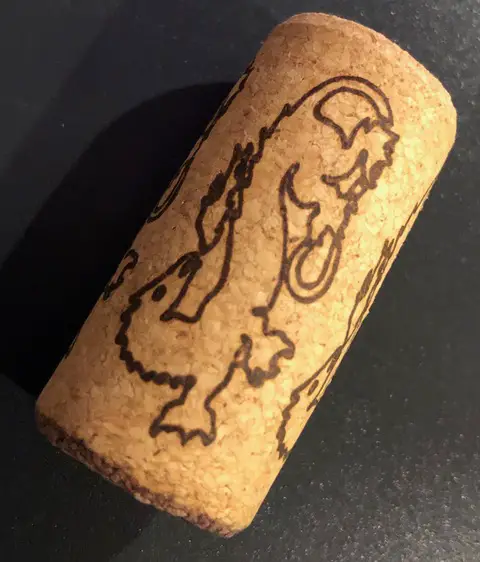
That July night, I opened some red wine, and out came a cork, to my astonishment, with a dragon on the side. Appropriate, I said, telling her, that yes, it was time to sell our house, move to a small flat across town we owned, and free ourselves of accumulated debris, ready to launch to Ljubljana.
And so we began our daunting downsizing, promising to be careful with every step to avoid injury, to move methodically, poco y poco, bit by bit, as they say in New Mexico.
We proceeded, dumping and selling stuff, giving away things, including some century-plus-old heirlooms the we kept through multiple moves — Kate's grandmother's pedal sewing machine, and my Slovenian's grandparents' chandelier.
Out went my reel tapes, recorded with music on what I thought was cutting-edge technology. We told close friends about our plans, cementing our commitment. We began moving things to our flat, and rented small storage units below, to store clothes, art, my writing files and music.
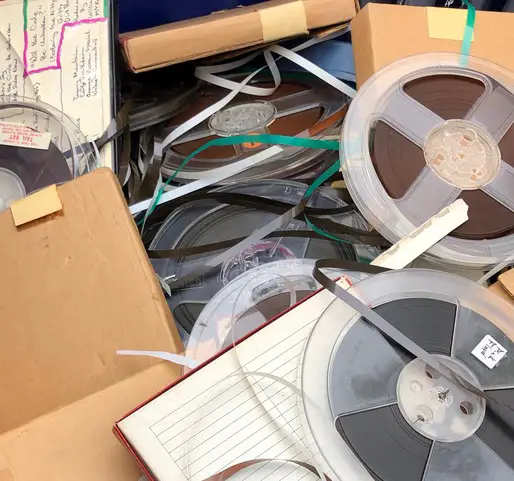
2020 arrived, and we were on track to put the house on the market, targeting March. But then the COVID roof fell in, our lockdown isolation began, and life screeched to a halt.
By July, the virus seemingly subsiding, we warily proceeded with selling. The Albuquerque real estate market was hot, but we quickly found we underestimated our task. One sale failed three days before we closed the deal, so we put it on the open market, bringing a parade of masked realtors and prospective buyers. Meanwhile, our next-door neighbor, an American our age with Canadian citizenship, told us he was fed with up the USA and was moving to Canada — he sold his house in a few hours.
We learned that real estate in the USA is mafia-like — inspectors finding flaws, so-called "cousin contractors" hired to fix them, appraisers to set value. Finally, a young couple with a child— amazingly, with a chance connection to Kate's daughter who lives in Costa Rica—made an offer, and Oct. 30 we sealed the deal, frantically moving out our last stuff.
Settling in Albuquerque, pondering Slovenia
Our "loft" is in a "condominium," with individual ownership, and joint common-area ownership. We're on the third floor above storied Route 66 a few blocks from downtown Albuquerque. By Ljubljana standards, it's large, about 82 square meters, but rather than green hills, our view is New Mexico desert.
The populations of Slovenia and New Mexico are roughly equal, but New Mexico is five times larger in area than Slovenia. Albuquerque is three times the size of Ljubljana, the dragon city, and shares some similarities. New Mexico has a unique culture, a complicated blend of tribal, Spanish, Mexican and Anglo peoples, and more recently Albuquerque has evolved as a center of arts, music and poetry.
Unlike Ljubljana, it's rough around the edges, with high crime, homelessness and family dysfunction, a sort of "bad neighborhood," as a Balkan official once characterized the Balkans. Yet I find Albuquerque and New Mexico and the Balkans interestingly similar in a nice sort of way. Our Bulgarian friend, Alex, who we met by chance in Sofia in 1993, told us, roughly translated, "our shirt may be dirty but we know how to have a good time." Such is New Mexico, a poor state, but unpretentious and fun, on the peaceful, upbeat side of things.
Meanwhile, our new downtown loft life unfolds, amid the pandemic. Like Slovenia, New Mexico's COVID spiked in the spring, but lessened as summer arrived. In Slovenia, youthful fun in Croatia and at bars in Ljubljana, and in Albuquerque, parties and drinking, lead to the big Fall spike in cases — and deaths. New Mexico has more cases, but sadly, death tolls are similar — both around 2,000. Our New Mexico governor has also imposed stringent measures, but unlike Slovenia's right-wing prime minister, she's comes at it from the compassionate left, encountering stiff resistance from the rural right.
After our hectic move, we stay mostly in, venturing out weekly to stock up on food, during special hours for older folks at our well-managed organic grocery co-op. We avoid social contact, though we maintain Zoom "happy hours" with our poet, artist and journalistic friends.
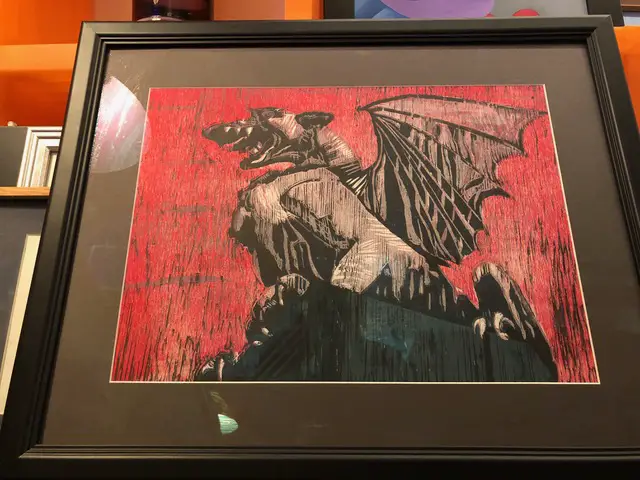
And savor our so-far good fortune, though Ljubljana seems distant. Our loft is filled with bits of Slovenia — Kate's stunning dragon woodcut (based on her 2018 Ljubljana photo) and one of my blacksmith grandfather's handmade tools. We shuffle around in Slovenian slippers. And I concoct my version of čemaž, my daily morning staple.
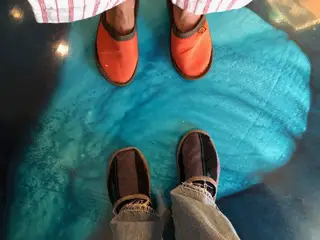
The key & the lock: Fulfilling our Slovenia dream
When I sought Slovenian citizenship, I wrote in my application that I would be following one of my Slovenian grandmother's dream — to return. She never did, marooned in Wyoming, but now it's my, and Kate's, dream.
During multiple visits to Slovenia, beginning, by chance, in 1991, just months after independence, we've encountered, by chance, numerous nice folks who helped us along the way, poco y poco, unbeknownst to us, on our path back: Stan, the lawyer with cousins in Wyoming, partner Dragica, and Natasha, his daughter, now a banker, and in 2018 our high-rise flat neighbor; Spanish-speaking Pablo, an Argentine Slovene who returned in 1991 to work on the revived Slovenc newspaper who's also a poet, translator and librarian, and spouse Liliana, who works at the Spanish Embassy; Jasmina and Urban, from whom we rented our Trubarjeva flat and, like us, avid vegetarians, and Carlos, the Mexican writer, who married Slovenian Mojca — at his theater, we met Sonja, and discovered the Mura River.
It was at the Mura where I met Stojan, and over a Lasko, I told him about our string of coincidences, and also my discovery of an intriguing version of Que Sera, Sera, a Spanish song, by a French "trip-hop" group, Wax Tailor, that essentially says, yes, "whatever will be, will be," but if you have the key, you just have to find the lock to alter life.
Stojan tells me that that the root word for coincidence in Slovene is "nakljucje." My Anglesko-Slovenski slovar translates "key" to "kljuc," a word I heard often growing up in a Wyoming-Slovenian culture.
It's not Ljubljana, but our loft offers a window of hope, of following our dream there, and returning to Albuquerque occasionally, to visit family and our cohort of like-minded friends here who also nurture our souls.
Inside, and isolated, we thankfully have move-in tasks to complete, mostly heart-warming, like hanging random art we purchased during our travels. Now, with Kate immersed in her art in a tiny downtown studio that we found, yes, by chance, and writing poetry in the loft, and I, with my eclectic music to savor and time to write, we wait out the pandemic.
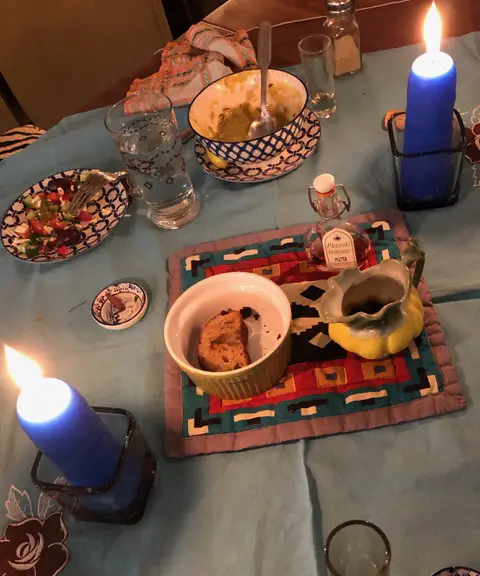
For our "thanksgiving" we cooked a vegetarian feast, lit our table candles — and savored Pleterski brinjevec, saved from our 2018 journey.
It's not Ljubljana, but I call it "Ljubljana luxury," surrounded by our "riches." Our dream continues, and we have the lock — and the key.
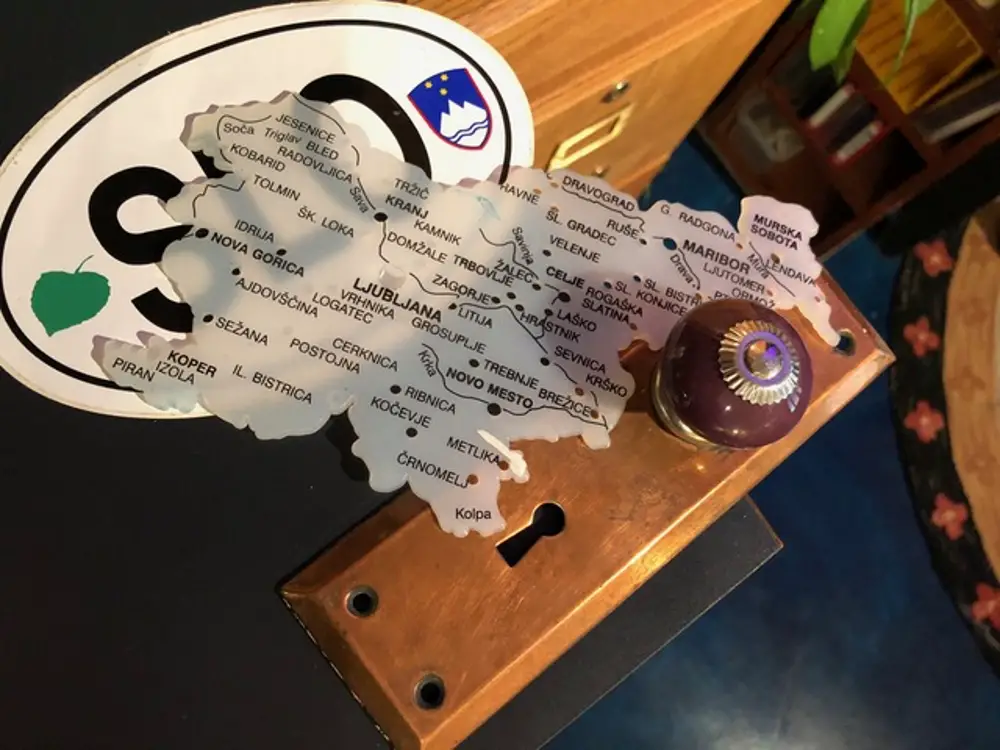
STA, 13 December 2020 - A total of 830 people tested positive for coronavirus in Slovenia on Saturday as 31.3% of the tests came back positive. Government data also show Covid-19 hospitalisations rising above 1,300 and 22 more patients losing their lives.
A total of 1,315 Covid-19 patients were treated in hospitals yesterday, 39 more than the day before, despite 52 being discharged home. The number of patients in intensive care units rose by eight to 201.
A total of 2,648 tests for Sars-Cov-2 were conducted yesterday.
With the latest fatalities, the country's death toll from Covid-19 has risen to 2,063. The total case count since the start of the pandemic has exceeded 96,300.
The 7-day average of new cases is 1,497.3, according to tracker site covid-19.sledilnik.org.
All our stories on Slovenia and coronavirus





